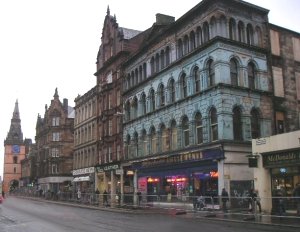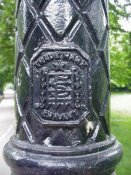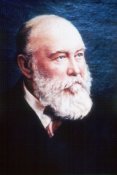 |
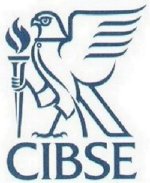 |
BRITANNIA MUSIC HALL TRONGATE GLASGOW
|
Many people will have seen
this lovely example of a Victorian Music Hall on last years BBC
Restoration
series. The Music Hall is to be the subject of grant applications from
the
Heritage Lottery Fund and Historic Scotland, which if successful will
help
towards the intention of restoring the auditorium to its late Victorian
condition.
|
The
Mechanical & Electrical Services The Music Hall was
originally gas light. The main features were three gasoliers at
auditorium
ceiling level with gas mantles located around the perimeter walls.
Remnants of
the old gas mantle piping can still be seen at gallery level. The building was heated
by
coal fires and a few of their fire places can still be found there. The
auditorium had a natural form of ventilation. The suspended ceiling is
formed
as an open box grid design with a mesh fixed above the grid. The heat
from the
people and gas lighting created sufficient stack effect for the
vitiated air to
rise and exit through louvred vents at roof level. Three suspended tungsten
light fittings of two different patterns are still in place. One is
possibly an
original 1897 fitting and the others date from the 1920’s. Red and
white ‘Exit’
and ‘Gents’ illuminated signs can still be seen.
|
|
Gaslighting
– An Introduction to the “House of Sugg”. By Chris Sugg the Great – great – grandson of William Sugg, the founder of the firm. |
|
The Westminster portcullis with the
phrase “En Avant” was the logo of William Sugg & Co. Ltd during the
Victorian era when it became arguably the most important manufacturer
of gas
lighting in the world.
Thomas Sugg, an ironmonger, is
credited
with “making and laying” the first gas pipe which was used for the
first
demonstration of gas lighting in the capital in 1807.
His son, William, formed William Sugg & Co. in 1837
and his
son, William Thomas became the driving force after his father’s death
in 1860
right through to 1907. |
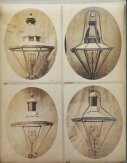 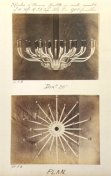 The lanterns illustrated above reached 7ft in height and 46” across, requiring substantial and imposing lamp posts to support them. Meanwhile the electrical industry had been developing. Although the early arc lamps could produce huge amounts of light they were very unreliable and expensive to run. The invention of the gas mantle turned the tables on the electricians, retaining the lead of gas for street lighting for something like another 50 years. They also provided the death knell for the enormous lanterns which is why they are so rare today. The well known Windsor lantern introduced by William Sugg in 1898 was the first lantern designed specifically to use the gas mantle. Sugg’s had manufactured no less than 50,000 Windsor lanterns by the time the 1906 catalogue was printed, a staggering number in 8 years and largely by hand. 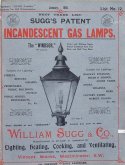
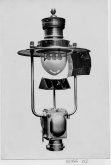 Although there are many Sugg gas lights that came after William’s death, the Rochester and Littleton shadowless lanterns are by far the most popular and recognizable, particularly because of the huge numbers used by the railways and the surprising number that are still in use today, particularly in places such as Westminster and Covent Garden - still running on gas. |
THREE WELSH NATIONAL TRUST CASTLES
CHIRK –
PENRHYN – POWIS.
|
HG members
Mike Barber and Frank Ferris made a visit to
these three National Trust properties in November 2003, to discover,
survey and
photograph for the Trust’s Technology Survey any engineering items of
significant historical interest. Penrhyn and Powis both proved to
contain a
small treasure trove of H&V equipment.
 Penryhn
Castle finished
c1840 for the Pennant family
originally had a warm air stove providing heating to the
ground floor
rooms.
Sadly all that remains of the original system is a few
ornate pattern
floor
grilles. The brickwork vent ducts are still in use but the
heating for
these
rooms is now provided by a modern style air handling unit.
Several old
types of radiators were found and
recorded, all of which appear to date from the late Victorian
period.
One pattern of sectional radiator used
composition type gaskets, with tie-bars used for assembly.
This
pre-dates the
more common sectional pattern which uses
left / right hand threaded nipples for assembly. These
radiators were manufactured by Haden’s of Trowbridge. Research
at
the
Wiltshire
record Office found Penrhyn Castle in a list of
buildings heated by
G & J Haden.
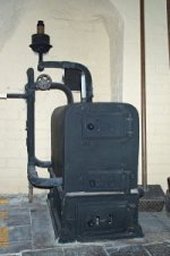 A well preserved cast iron saddle type boiler still remains in the Kitchen complete with its mountings and connecting pipework. the boiler was used to heat the stable block. |
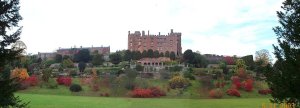 Powis
Castle was bequeathed by the
Powis family to The National Trust in
1952. Quadrant style radiators of William Graham design are fitted in
the Oak Drawing Room. the nameplates fitted to the radiator wheel
valves identified Richard Crittall to be the installer of the heating
system.
The derelict remains
of a G & J Haden warm air stove was found which was used to heat
the Orangery. Research again carried out at the Wiltshire Record Office
found the stove to be number 556 ordered in 1841.
The old stable block still has the original ceiling mounted Musgrave & Co extract fan fitted complete with its DC motor, but now disused. For greater detail of the H&V equipment found at Powis Castle visit the HG website. Chirk Castle
sadly
did not have the same amount of historical items, the heating system
having been upgraded in the 1920's
The
property originally had its own gas producing plant, but now only
the derelict buildings remain. One unusual item found in the Laundry was a vertical pattern solid fuel boiler which provided hot water to the laundry sinks. |
|
Following the
February
AGM meeting of the HG a visit was
made to the House of Lords Records Archive, to attend a talk explaining
about
the records held by the archive, and the progress being made to make
them
available on the Internet to provide easier access for researchers.
Many
interesting documents were made available for members to read, relating
to
Goldsworthy Gurney’s reports on his recommendations to overcome the
ventilation
problems in the House of Commons during the 1850’s.
An exciting find of a
saddle shaped boiler was made during excavations being carried out for
new
construction works at Oxford Prison. A services drawing dating back to
1841 has
been found which shows that it was a water boiler which heated the
Cells by
means of pipework supplying a heater battery sited in the base of the
ventilation shaft.
In
March HG members Mike Barber and Frank Ferris visited the Vaynol Estate
in North Wales. This organisation is currently running courses for
craftsmen who work on historic buildings. They have invited the HG to
provide advice on how any historic engineering services should be
retained within the restoration works of the building. Also how any new
engineering services should be designed, installed and integrated
sympathetically to suit the requirements of historic and listed
buildings. Anyone wanting to make contact with this organisation should
contact Brenda Rhodes, telephone No. 01248 - 670444. The late
great poet
laureate John Betjamin had an eye for the old warm air stove. In his
poem
‘Christmas’ he writes The
bells of waiting Advent ring The
Tortoise stove is lit again And
lamp-oil light across
the night
Has caught the streaks of winter
rain..........The HG website continues to expand. More pages added to the Picture Gallery and Items of Interest. |
Have you ever
thought
and wondered “How did the Heritage
Group get started”. Well now we know. In 1972 Mike Barber and the late
Ken Dale
coincidentally both wrote letters to the then IHVE Secretary. Both
suggested that
as it was the 75th anniversary of the founding of the
Institution, a
serious effort should be made to preserve the fascinating history of
the
building services industry. The rest as they say, is now history.
This is the Centenary year of the Heating and Ventilating Contractors Association. To celebrate this occasion a book titled "HVCA@100" has been published which is a "jumbo" sized pictorial history of the Association and the industry. The book's author is HG Chairman Brian Roberts, with Paul Yunnie the HG Vice-Chairman and MD of Andrews Water Heaters who were the sponsors of the book. The many and varied illustrations of people, buildings, systems and equipment have largely been taken from the Heritage Group's own collection and HVCA archives. 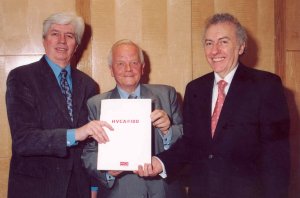 Pictured at the launch on the 10th March 2004 of the HVCA Centenary book (l-r) Brian Roberts Brian Townsend (President HVCA 2003-4) and Paul Yunnie. The Ed has made contact with and visited descendants of the Phipson family. They have kindly provided copies of photographs or portraits of Wilson Phipson's father, older brother and younger sister. But that elusive likeness of Wilson is still out there waiting to be discovered. Visit the HG Website for details. HG member Ian Stewart has been in contact with the Britannia Music Hall Trust in Trongate Glasgow. See article on front page of Newsletter. |
